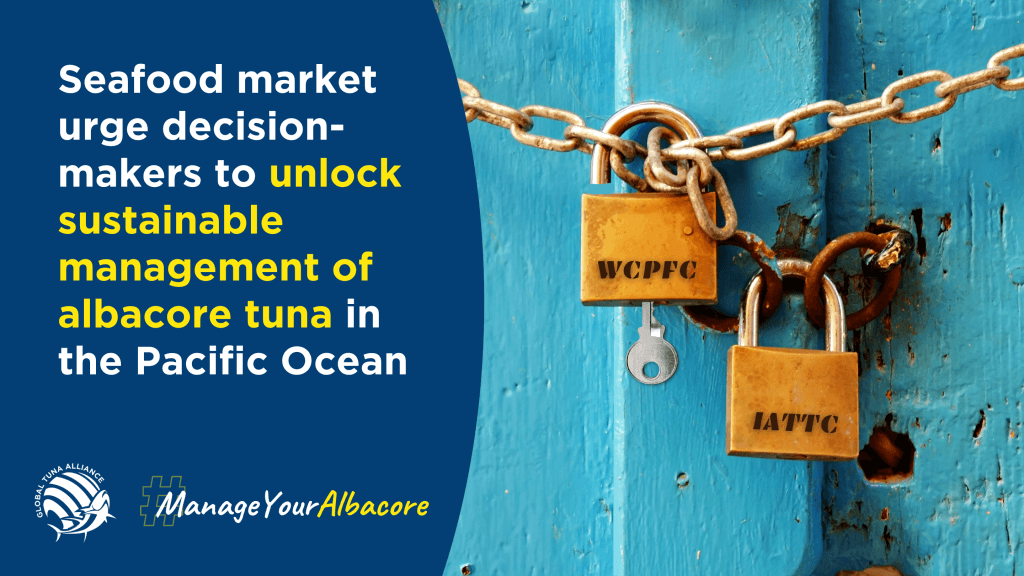
The Global Tuna Alliance (GTA) – an independent association of 49 seafood supply chain companies and retailers from 5 continents – have welcomed two proposals submitted to the 101st Session of the Inter-American Tropical Tuna Commission (IATTC) which would advance science-based, sustainable management measures for albacore tuna stocks in the Eastern Pacific. However, whether these proposals are adopted at the meeting taking place between 7 – 11 August remains to be seen, with GTA Partners warning at a recent roundtable meeting that a lack of progress could have ramifications for their approach to sourcing in the region.
Albacore tuna in the Pacific Ocean is split into two separate stocks: North Pacific (NP) albacore and South Pacific (SP) albacore, and is managed by two Regional Fisheries Management Organisations (RFMOs): IATTC who manage stocks in the Eastern Pacific Ocean and the Western-Central Pacific Fisheries Commission (WCPFC). As shared stocks, the effectiveness of management measures is somewhat dependent on both Commissions working in tandem.
There is a harvest strategy (a framework for making management decisions) already in place for the northern stock with progress made at last year’s IATTC meeting. However, a crucial element of a harvest strategy – harvest control rules (HCRs) – were absent from the strategy. HCRs set predetermined catch or fishing effort limits that are based on the status of a stock. In early July, the WCPFC northern committee amended their own NP albacore harvest strategy to include HCRs. Ahead of the August meeting, Canada, Japan and the U.S. have tabled a proposal to IATTC to bring its harvest strategy in line with WCPFC.
Similarly, while WCPFC has fishing controls in place for the SP albacore fishery, this currently does not extend to the IATTC Convention Area outside the overlapping region. A proposal by Ecuador to IATTC seeks to prevent producing countries from increasing the number of active longline vessels fishing for SP albacore to achieve compatibility with WCPFC.
The GTA’s Director of Outreach and Engagement, Albert Arthur said:
“You can think of the situation like a door with two locks. While WCPFC has one key, it also needs IATTC to turn its own key to unlock the measures we need for effective, sustainable management of Pacific albacore stocks.”
As part of their campaign ahead of IATTC, the GTA organised a roundtable discussion between its Partners and IATTC delegates, which took place on the 27th July. This was an opportunity for delegates to hear directly from the market. Of IATTC’s 21 member states, 30% sent delegates to attend, up from three the year before.
During the roundtable, Stacy Shultz, Director of Marketing & Sustainability Coordinator at Fortune Fish & Gourmet, a U.S. seafood processor and distributor, reflected on the importance of sustainably sourced products to their customers:
“Our commitment to environmental stewardship and responsible sourcing is a core business philosophy. Sustainable tuna sourcing is not just a buzzword for us, it’s part of our identity.
“We firmly believe that by supporting sustainable fishing practices, we play a critical role in safeguarding the health of our oceans and preserving marine biodiversity for generations to come.
“Our customers trust us to provide them with the best of the best seafood products. By offering sustainable tuna options, we can satisfy our customers’ demands for environmentally conscious products while ensuring the long-term viability of these tuna stocks.”
Similarly, Hamish Walker, the Chief Operating Officer and Chief Sustainability Officer at Colorado-based seafood supplier Seattle Fish Company issued a warning that their approach to sourcing will always prioritise well-managed stocks:
“For us, having a sustainable supply of tuna is critical. If that means taking some difficult decisions in the short-term for the long-term future of our business and our industry, that is something we will do.
“We will take decisions based on sustainability first and profit second.”
Commenting on the roundtable’s attendance, Mr. Arthur commented that:
“The uptick shows that decision-makers are starting to take note of the market’s views. It’s important for delegations – especially those from producing countries – to listen, as failing to do so could have detrimental consequences if the supply chain decided to withdraw their sourcing from the area.”
Along with their albacore-oriented campaign, the GTA has published a position statement which also covers the management and design of Fish Aggregating Devices (FADs) and measures to improve the transparency of the industry such as adopting minimum standards for an electronic monitoring program and adopting a 100% observer coverage requirement by 2024.
Commenting on the GTA’s full set of asks, Mr. Arthur said:
“Improving the transparency of tuna fisheries in the Eastern Pacific Ocean was the key focus of our campaign last year. However, opposition by a group of some Asian countries frustrated attempts at getting key measures passed. We’re hoping that they get behind Ecuador’s plan to require human observers or electronic monitoring onboard all longline vessels 20 metres or longer by 2027.
“This would represent a great leap toward the GTA’s objective of ending illegal, unreported and unregulated (IUU) fishing. This scourge results in human rights abuse at-sea and inaccurate data on catches, which in turn affects our ability to manage stocks sustainably. Without full transparency in the region, our Partners may look elsewhere for their tuna.”
The GTA have published a document fully responding to the proposals on the table at IATTC this year.